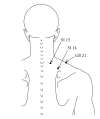Comparative effects of acupressure at local and distal acupuncture points on pain conditions and autonomic function in females with chronic neck pain
- PMID: 20953433
- PMCID: PMC2952311
- DOI: 10.1155/2011/543291
Comparative effects of acupressure at local and distal acupuncture points on pain conditions and autonomic function in females with chronic neck pain
Abstract
Acupressure on local and distal acupuncture points might result in sedation and relaxation, thereby reducing chronic neck pain. The aim was to investigate the effect of acupressure at local (LP) and distal acupuncture points (DP) in females with chronic neck pain. Thirty-three females were assigned to three groups: the control group did not receive any stimuli, the LP group received acupressure at local acupuncture points, GB 21, SI 14 and SI 15, and the DP group received acupressure at distal acupuncture points, LI 4, LI 10 and LI 11. Verbal rating scale (VRS), Neck Disability Index (NDI), State-Trait Anxiety Inventory (STAI), muscle hardness (MH), salivary alpha-amylase (sAA) activity, heart rate (HR), heart rate variability (HRV) values and satisfaction due to acupressure were assessed. VRS, NDI, STAI and MH values decreased after acupressure in the LP and the DP group. HR decreased and the power of high frequency (HF) component of HRV increased after acupressure in only the LP group. Although acupressure on not only the LP but also the DP significantly improved pain conditions, acupressure on only the LP affected the autonomic nervous system while acupuncture points per se have different physical effects according to location.
Figures











Similar articles
-
The Influence of Acupressure at Extra 1 Acupuncture Point on the Spectral Entropy of the EEG and the LF/HF Ratio of Heart Rate Variability.Evid Based Complement Alternat Med. 2011;2011:503698. doi: 10.1093/ecam/nen061. Epub 2011 Feb 17. Evid Based Complement Alternat Med. 2011. PMID: 18955366 Free PMC article.
-
The effect of acupressure at the extra 1 point on subjective and autonomic responses to needle insertion.Anesth Analg. 2008 Aug;107(2):661-4. doi: 10.1213/ane.0b013e31817b8495. Anesth Analg. 2008. PMID: 18633049 Clinical Trial.
-
Distal traditional acupuncture points of the large intestinal meridian and the stomach meridian differently affect heart rate variability and oxygenation of the trapezius muscle.Evid Based Complement Alternat Med. 2014;2014:283010. doi: 10.1155/2014/283010. Epub 2014 Feb 19. Evid Based Complement Alternat Med. 2014. PMID: 24696701 Free PMC article.
-
Clinical effects of acupressure on neck pain syndrome (nakchim): a systematic review.Integr Med Res. 2018 Sep;7(3):219-230. doi: 10.1016/j.imr.2018.01.002. Epub 2018 Jan 31. Integr Med Res. 2018. PMID: 30271710 Free PMC article. Review.
-
Clinical Evidence for Association of Acupuncture and Acupressure With Improved Cancer Pain: A Systematic Review and Meta-Analysis.JAMA Oncol. 2020 Feb 1;6(2):271-278. doi: 10.1001/jamaoncol.2019.5233. JAMA Oncol. 2020. PMID: 31855257 Free PMC article.
Cited by
-
Reduced Pain by Mind-Body Intervention Correlates with Improvement of Shoulder Function in People with Shoulder Pain: A Randomized Controlled Trial.Evid Based Complement Alternat Med. 2022 Mar 24;2022:6149052. doi: 10.1155/2022/6149052. eCollection 2022. Evid Based Complement Alternat Med. 2022. PMID: 35368768 Free PMC article.
-
Analysis and Thoughts about the Negative Results of International Clinical Trials on Acupuncture.Evid Based Complement Alternat Med. 2015;2015:671242. doi: 10.1155/2015/671242. Epub 2015 Jun 16. Evid Based Complement Alternat Med. 2015. PMID: 26161126 Free PMC article. Review.
-
Effects of acupuncture and acupressure of the acupoint compared to the tendon on the blood circulation of human tendon in vivo.Eur J Appl Physiol. 2024 Jan;124(1):269-279. doi: 10.1007/s00421-023-05277-2. Epub 2023 Jul 15. Eur J Appl Physiol. 2024. PMID: 37452889 Free PMC article.
-
Chronic neck pain: making the connection between capsular ligament laxity and cervical instability.Open Orthop J. 2014 Oct 1;8:326-45. doi: 10.2174/1874325001408010326. eCollection 2014. Open Orthop J. 2014. PMID: 25328557 Free PMC article.
-
Diversity of Acupuncture Point Selections According to the Acupuncture Styles and Their Relations to Theoretical Elements in Traditional Asian Medicine: A Data-Mining-Based Literature Study.J Clin Med. 2021 May 11;10(10):2059. doi: 10.3390/jcm10102059. J Clin Med. 2021. PMID: 34064891 Free PMC article.
References
-
- Jimbo S, Atsuta Y, Kobayashi T, Matsuno T. Effects of dry needling at tender points for neck pain (Japanese: Katakori): near-infrared spectroscopy for monitoring muscular oxygenation of the trapezius. Journal of Orthopaedic Science. 2008;13(2):101–106. - PubMed
-
- Irnich D, Behrens N, Gleditsch JM, et al. Immediate effects of dry needling and acupuncture at distant points in chronic neck pain: results of a randomized, double-blind, sham-controlled crossover trial. Pain. 2002;99(1-2):83–89. - PubMed
-
- Cambron JA, Dexheimer J, Coe P, Swenson R. Side-effects of massage therapy: a cross-sectional study of 100 clients. Journal of Alternative and Complementary Medicine. 2007;13(8):793–796. - PubMed
-
- Arai Y-CP, Ushida T, Osuga T, et al. The effect of acupressure at the extra 1 point on subjective and autonomic responses to needle insertion. Anesthesia and Analgesia. 2008;107(2):661–664. - PubMed
LinkOut - more resources
Full Text Sources
Research Materials
Miscellaneous

